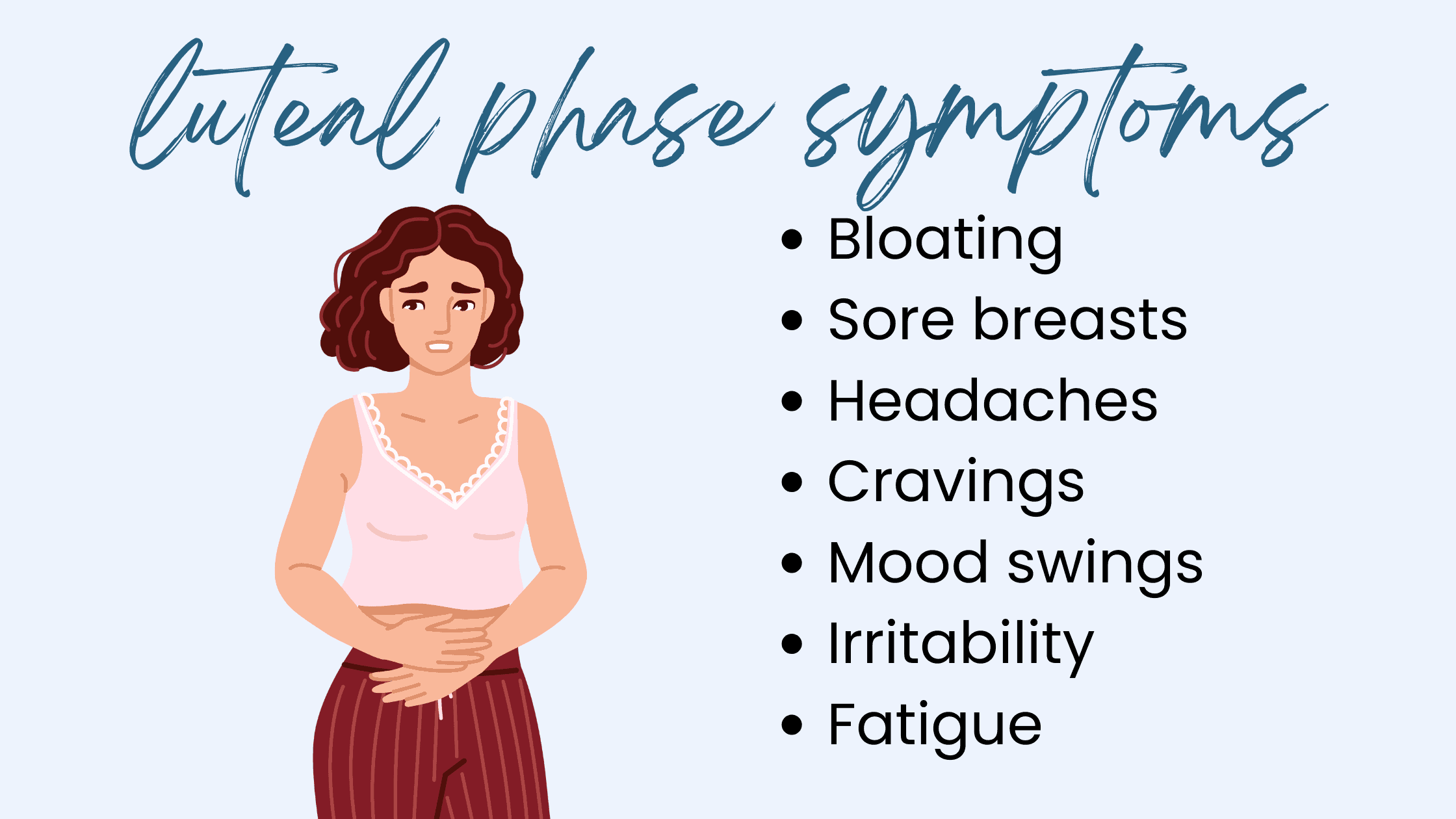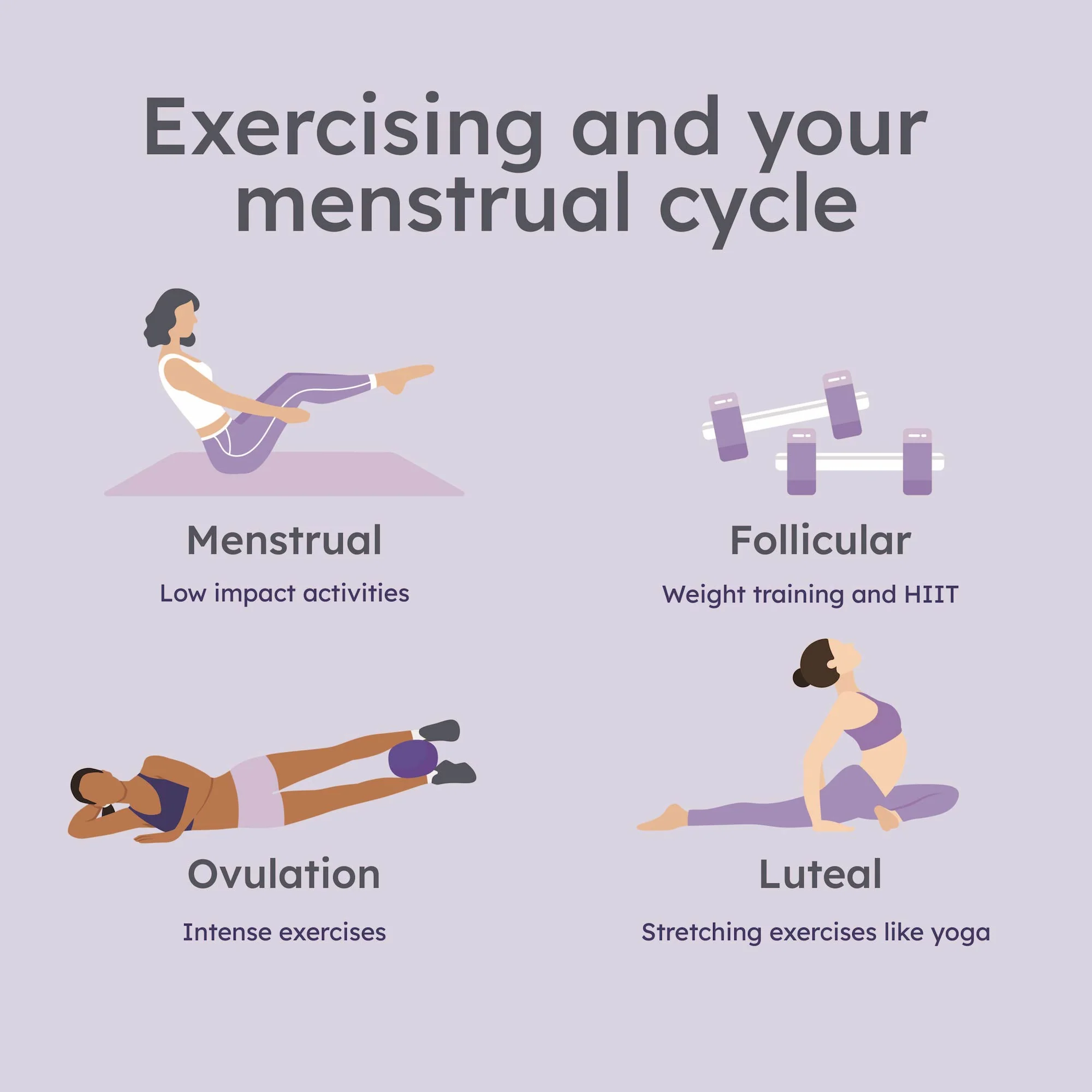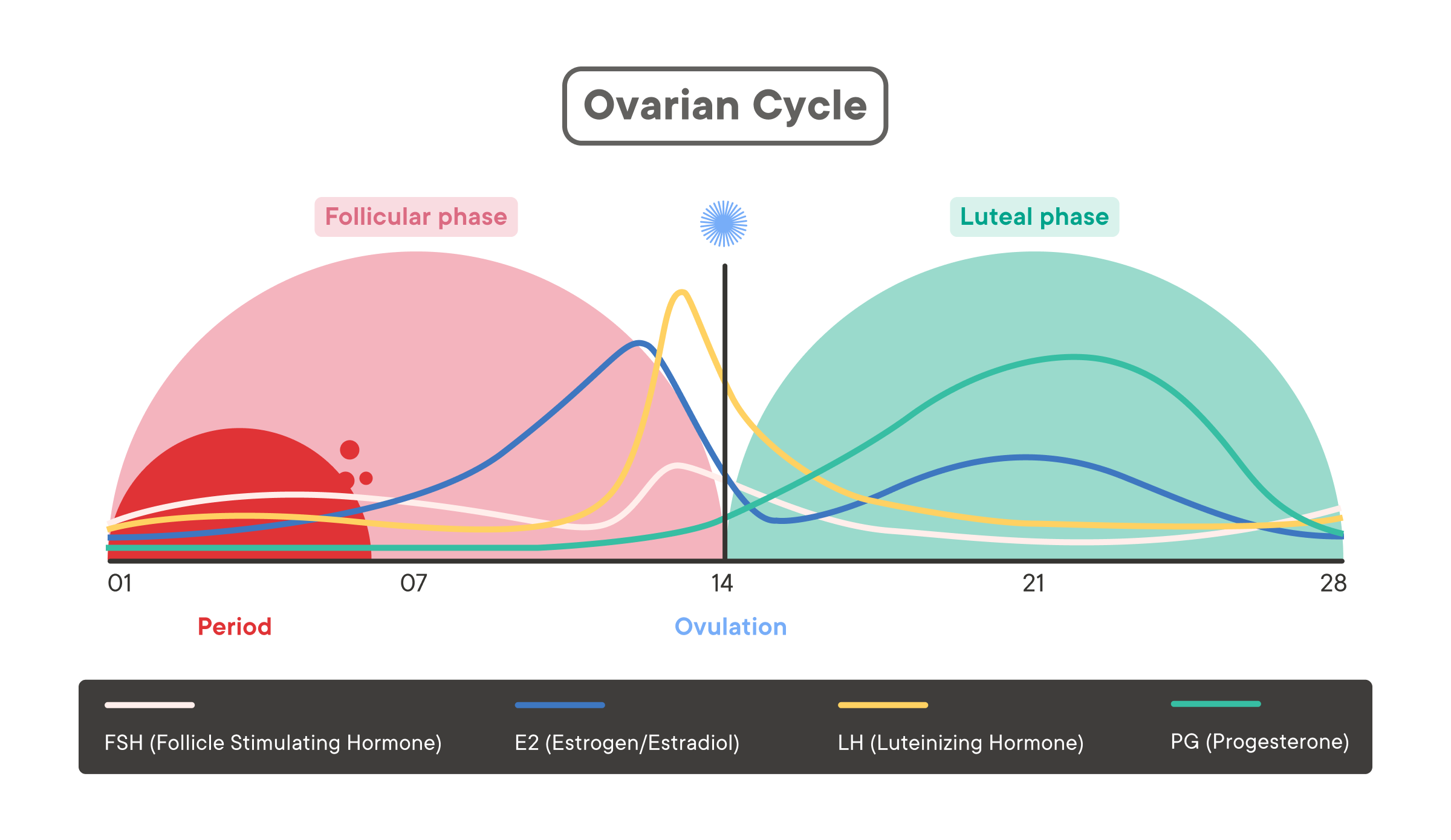
The luteal phase is the latter half of the menstrual cycle, starting after ovulation. It typically lasts about 14 days.
The luteal phase plays a crucial role in the menstrual cycle, occurring after ovulation and before menstruation. During this time, the corpus luteum forms and releases progesterone, preparing the uterus for a potential pregnancy. Progesterone thickens the uterine lining, making it suitable for a fertilized egg to implant.
If fertilization does not occur, progesterone levels drop, leading to the shedding of the uterine lining and the start of menstruation. Understanding the luteal phase is essential for those tracking fertility or managing menstrual health. It can also help in identifying any hormonal imbalances or issues related to reproductive health.

Credit: nourishedwithnina.com
Introduction To The Luteal Phase
The luteal phase is a crucial part of the menstrual cycle. It occurs after ovulation and before the start of menstruation. Understanding this phase helps in tracking fertility and menstrual health.
Role In Menstrual Cycle
During the luteal phase, the body prepares for a possible pregnancy. The corpus luteum forms from the follicle that released an egg. This structure produces progesterone and some estrogen.
Progesterone thickens the uterine lining. This prepares the uterus for a fertilized egg. If no fertilization occurs, hormone levels drop, leading to menstruation.
Duration And Timing
The luteal phase typically lasts 14 days. It starts after ovulation and ends with the start of menstruation. The exact duration can vary slightly among individuals.
Here is a simple table to illustrate the timing:
| Phase | Duration |
|---|---|
| Follicular Phase | 1-14 days |
| Ovulation | Day 14 |
| Luteal Phase | 15-28 days |
Tracking your cycle can help identify the luteal phase. Cycle tracking apps can be useful for this purpose.
Hormonal Changes
The luteal phase is a crucial part of the menstrual cycle. It occurs after ovulation and before the period starts. During this phase, the body undergoes significant hormonal changes. These changes prepare the body for a potential pregnancy. Let’s explore the key hormonal shifts that happen during this phase.
Progesterone Surge
After ovulation, the corpus luteum forms. This structure releases progesterone. Progesterone levels rise significantly during the luteal phase. This hormone helps thicken the uterine lining. A thicker lining supports a fertilized egg. High progesterone levels also prevent further ovulation.
If pregnancy does not occur, the corpus luteum breaks down. This causes progesterone levels to drop. A drop in progesterone triggers the menstrual period. Here is a simple table to show the changes:
| Time Period | Progesterone Level |
|---|---|
| Early Luteal Phase | Low |
| Mid Luteal Phase | High |
| Late Luteal Phase | Decreasing |
Estrogen Fluctuations
Estrogen levels also change during the luteal phase. These levels rise and fall throughout the cycle. Estrogen helps maintain the uterine lining. In the luteal phase, estrogen levels rise initially. This rise works alongside progesterone. Both hormones prepare the uterus for a possible pregnancy.
Later in the luteal phase, estrogen levels decrease. This decrease, along with progesterone, signals the body. It indicates that pregnancy has not occurred. Here is an ordered list to summarize:
- Estrogen rises after ovulation.
- Estrogen supports the uterine lining.
- Estrogen levels fall if no pregnancy occurs.
These hormonal changes are vital for the menstrual cycle. They regulate the body’s readiness for pregnancy. Understanding these changes can help in tracking menstrual health.
Symptoms And Signs
The luteal phase is the second half of the menstrual cycle. Many women experience various symptoms and signs during this phase. These can range from physical discomforts to emotional changes.
Physical Indicators
During the luteal phase, physical indicators can be quite prominent. Some common physical signs include:
- Breast tenderness
- Abdominal bloating
- Headaches
- Fatigue
- Acne breakouts
These physical changes result from hormonal shifts. The body prepares for a possible pregnancy. As a result, estrogen and progesterone levels fluctuate. This can cause various symptoms.

Emotional Changes
Emotional changes are also common during the luteal phase. Women may experience mood swings and irritability. Here are some typical emotional changes:
- Increased anxiety
- Depression
- Heightened sensitivity
- Difficulty concentrating
- Sleep disturbances
These emotional changes are due to hormonal variations. The brain reacts to these shifts, impacting mood and mental state. Understanding these signs can help manage them better.
Fertility And Conception
The luteal phase is vital for fertility and conception. It happens after ovulation and before your period starts. This phase helps prepare your body for a possible pregnancy.
Optimal Conditions
During the luteal phase, your body needs optimal conditions. Your progesterone levels should be high. This hormone supports the uterine lining. A healthy lining helps an embryo implant.
Here are some key factors:
- Balanced hormones
- Proper nutrition
- Good overall health
These factors help create a fertile environment. A healthy lifestyle boosts your chances of conception.
Challenges And Solutions
Some women face challenges during the luteal phase. Low progesterone can be a problem. It may lead to a short luteal phase.
Here are some common challenges and their solutions:
| Challenge | Solution |
|---|---|
| Short luteal phase | Seek medical advice for hormone therapy. |
| Low progesterone | Consider progesterone supplements. |
| Poor diet | Follow a balanced diet rich in nutrients. |
Addressing these challenges can improve fertility. Consult a healthcare provider for personalized advice.
Impact On Mood
The luteal phase is the second half of the menstrual cycle. It starts after ovulation and ends when menstruation begins. During this phase, many women experience significant changes in mood. This can be due to hormonal fluctuations, particularly in progesterone and estrogen levels.
PMS And PMDD
PMS (Premenstrual Syndrome) and PMDD (Premenstrual Dysphoric Disorder) are common during the luteal phase. PMS affects many women with symptoms like:
- Bloating
- Fatigue
- Mood swings
PMDD is a more severe form of PMS. It includes intense emotional and physical symptoms such as:
- Severe irritability
- Depression
- Anxiety
Both conditions can severely impact daily life.
Coping Strategies
Managing mood changes during the luteal phase is essential. Here are some effective coping strategies:
- Exercise Regularly: Physical activity boosts mood.
- Eat a Balanced Diet: Nutrients like calcium and magnesium can help.
- Practice Relaxation Techniques: Yoga and meditation reduce stress.
- Stay Hydrated: Drinking enough water can improve energy levels.
- Consult a Healthcare Provider: Sometimes medication or therapy is needed.
Implementing these strategies can help manage mood swings effectively. Always listen to your body and seek help if needed.
Diet And Nutrition
The luteal phase is the second half of the menstrual cycle. Diet and nutrition play a crucial role during this phase. Eating the right foods can help manage symptoms and promote overall well-being.
Key Nutrients
During the luteal phase, certain nutrients are especially important. These nutrients help balance hormones and support your body’s needs.
- Magnesium: Helps reduce bloating and mood swings. Foods rich in magnesium include spinach, nuts, and seeds.
- Vitamin B6: Supports mood regulation. Foods high in Vitamin B6 are bananas, chickpeas, and fish.
- Omega-3 Fatty Acids: Reduce inflammation and cramps. Good sources are salmon, flaxseeds, and walnuts.
- Calcium: Eases muscle cramps and helps bone health. Dairy products, leafy greens, and fortified plant milks are rich in calcium.
Foods To Avoid
Certain foods can exacerbate symptoms during the luteal phase. Avoiding these foods can help you feel better.
| Food | Reason to Avoid |
|---|---|
| Caffeine | Can increase anxiety and disrupt sleep. |
| Sugar | Causes blood sugar spikes and mood swings. |
| Processed Foods | High in unhealthy fats and additives. |
| Salty Foods | Can lead to bloating and water retention. |
Maintaining a balanced diet during the luteal phase is essential. Paying attention to key nutrients and avoiding harmful foods can make a big difference. Remember, small changes in your diet can lead to significant improvements in how you feel.
Exercise And Activity
The luteal phase is the second half of the menstrual cycle. It can impact energy levels and how the body responds to exercise. Understanding the best ways to stay active during this phase is key to maintaining health and well-being.

Recommended Exercises
During the luteal phase, it is important to focus on exercises that are less intense. The body might feel more tired than usual. Here are some exercises that are beneficial:
- Yoga: Helps in relaxing the body and mind.
- Walking: A low-impact exercise that can be easily adjusted to your pace.
- Swimming: Gentle on the joints and provides a full-body workout.
- Pilates: Focuses on core strength and flexibility.
Activity Adjustments
Adjusting activities to suit the luteal phase can make a big difference. Here are some tips to keep in mind:
- Listen to Your Body: Pay attention to how you feel. Do not push too hard.
- Hydrate Well: Keep yourself hydrated to manage energy levels.
- Modify Intensity: Lower the intensity of your workouts. Focus on form and breathing.
- Rest Adequately: Include more rest days if needed. Your body might need extra recovery time.
Understanding these adjustments can help in maintaining a balanced fitness routine. It ensures you stay active without over-exerting yourself.
Stress Management
The luteal phase can be challenging due to hormonal changes. Effective stress management is essential for maintaining balance and well-being. Let’s explore some practical ways to manage stress during this phase.
Relaxation Techniques
Relaxation techniques help reduce stress and promote calmness.
- Deep Breathing: Take slow, deep breaths to relax your body.
- Progressive Muscle Relaxation: Tense and then release each muscle group.
- Yoga: Engage in gentle yoga poses to stretch and soothe muscles.
- Warm Baths: Enjoy a warm bath with Epsom salts to ease tension.
Mindfulness Practices
Mindfulness practices keep you present and reduce anxiety.
- Meditation: Spend a few minutes focusing on your breath.
- Mindful Walking: Take a walk and pay attention to your surroundings.
- Gratitude Journaling: Write down things you are grateful for each day.
- Body Scan: Mentally scan your body for tension and release it.
| Technique | Benefits |
|---|---|
| Deep Breathing | Reduces heart rate and calms nerves |
| Progressive Muscle Relaxation | Releases physical tension |
| Yoga | Promotes flexibility and relaxation |
| Warm Baths | Soothes muscles and promotes calmness |
| Meditation | Enhances mental clarity |
| Mindful Walking | Increases awareness and reduces stress |
| Gratitude Journaling | Improves mood and positivity |
| Body Scan | Identifies and releases tension |

Credit: elara.care
Sleep Patterns
The luteal phase of the menstrual cycle can affect sleep patterns. Many women experience disrupted sleep during this time. Understanding these changes can help improve sleep quality.
Importance Of Rest
Getting enough rest during the luteal phase is crucial. Hormonal fluctuations can impact your sleep quality. Proper rest helps manage mood swings and physical discomfort. Lack of sleep may worsen symptoms like bloating and irritability.
During this phase, progesterone levels rise. This hormone can make you feel more tired. Ensuring adequate rest can improve your overall well-being. Make sleep a priority to help your body adjust to these changes.
Improving Sleep Quality
There are several ways to improve sleep during the luteal phase. Follow these tips to enhance your sleep quality:
- Stick to a consistent sleep schedule.
- Create a relaxing bedtime routine.
- Avoid caffeine and heavy meals before bed.
- Keep your bedroom cool and dark.
Consider using a sleep diary to track your sleep patterns. This can help identify any issues and improve your sleep habits. Here is a simple sleep diary template:
| Day | Time to Bed | Wake Up Time | Quality of Sleep (1-10) |
|---|---|---|---|
| Monday | 10:00 PM | 6:00 AM | 8 |
| Tuesday | 10:30 PM | 6:30 AM | 7 |
Using a sleep diary can help you notice patterns. This can lead to better sleep strategies. Pay attention to what works best for you.
Medical Interventions
The luteal phase is crucial in the menstrual cycle. Medical interventions can help manage symptoms and improve quality of life. These interventions range from hormonal therapies to alternative treatments.
Hormonal Therapies
Hormonal therapies can regulate the luteal phase. Doctors often prescribe progesterone supplements to support the luteal phase. Progesterone can help with PMS symptoms and regulate periods.
Another option is birth control pills. These pills contain hormones that balance the menstrual cycle. They can reduce heavy bleeding and painful periods.
In some cases, GnRH agonists may be used. These drugs help control hormone levels. They are often used for severe PMS or endometriosis.
| Therapy | Purpose | Benefits |
|---|---|---|
| Progesterone Supplements | Supports luteal phase | Reduces PMS symptoms |
| Birth Control Pills | Balances hormones | Reduces bleeding, pain |
| GnRH Agonists | Controls hormone levels | Treats severe PMS |
Alternative Treatments
Some prefer alternative treatments for the luteal phase. These treatments can include herbal remedies and dietary changes.
Herbal remedies such as chasteberry can help. Chasteberry is known to balance hormones and reduce PMS symptoms.
Dietary changes can also make a difference. Increasing vitamin B6 and magnesium intake can help. These nutrients support the luteal phase and reduce symptoms.
- Chasteberry for hormone balance
- Vitamin B6 for mood improvement
- Magnesium for reducing cramps
Acupuncture is another alternative treatment. It can help balance hormones and relieve pain.
Always consult a healthcare provider before starting any treatment.
Common Disorders
The luteal phase is crucial for a woman’s menstrual cycle. Some disorders can affect this phase, leading to various symptoms and complications. Below, we discuss two common disorders: Luteal Phase Defect and Polycystic Ovary Syndrome.

www.novaivffertility.com
Luteal Phase Defect
Luteal Phase Defect (LPD) occurs when the luteal phase is too short. This can cause issues with progesterone production. Progesterone is essential for maintaining pregnancy.
- Symptoms:
- Short menstrual cycles
- Spotting between periods
- Difficulty conceiving
- Causes:
- Stress
- High-intensity exercise
- Eating disorders
Polycystic Ovary Syndrome
Polycystic Ovary Syndrome (PCOS) is a hormonal disorder. It affects a woman’s ovaries and luteal phase. Women with PCOS may have irregular periods.
- Symptoms:
- Irregular menstrual cycles
- Excess hair growth
- Acne
- Causes:
- Insulin resistance
- Hormonal imbalances
- Genetics
| Disorder | Symptoms | Causes |
|---|---|---|
| Luteal Phase Defect | Short cycles, spotting, difficulty conceiving | Stress, exercise, eating disorders |
| Polycystic Ovary Syndrome | Irregular cycles, hair growth, acne | Insulin resistance, hormones, genetics |
Tracking And Monitoring
Tracking and monitoring your luteal phase can provide valuable insights into your health. Understanding this phase helps in planning pregnancies and managing symptoms. Let’s explore the best ways to track and monitor the luteal phase.
Methods And Tools
There are several methods to track the luteal phase. Here are some popular ones:
- Basal Body Temperature (BBT): Measure your BBT every morning before getting out of bed.
- Cervical Mucus: Check the consistency of your cervical mucus daily.
- Ovulation Predictor Kits (OPKs): Use OPKs to detect the surge in luteinizing hormone (LH).
- Mobile Apps: Utilize apps designed for tracking menstrual cycles and ovulation.
Here is a comparison table of these methods:
| Method | Pros | Cons |
|---|---|---|
| BBT | Accurate, low-cost | Requires daily tracking, affected by sleep patterns |
| Cervical Mucus | Free, gives immediate feedback | Subjective, can be confusing |
| OPKs | Easy to use, clear results | Costly, requires multiple tests |
| Mobile Apps | Convenient, integrates data | Depends on accuracy of data input |
Benefits Of Tracking
Tracking your luteal phase offers several benefits:
- Predict Ovulation: Helps in identifying the best time to conceive.
- Manage PMS: Understand patterns to better manage symptoms.
- Identify Irregularities: Spot any irregularities in your cycle early.
- Health Insights: Gain insights into your overall reproductive health.
Understanding your luteal phase can enhance your health awareness. It can also aid in planning for pregnancy.
Lifestyle Adjustments
The luteal phase is a crucial part of the menstrual cycle. Making some lifestyle adjustments can help manage symptoms and promote well-being. Below are some practical tips for daily routines and long-term changes.
Daily Routines
Daily habits can have a big impact on your luteal phase. Small changes can make a big difference.
- Exercise Regularly: Light exercise like walking can reduce stress and improve mood.
- Balanced Diet: Include fruits, vegetables, and whole grains. Avoid caffeine and sugar.
- Hydration: Drink plenty of water to stay hydrated.
- Sleep: Aim for 7-8 hours of sleep each night.
These simple adjustments can help your body feel better every day.
Long-term Changes
Long-term lifestyle changes can improve your luteal phase over time. These changes require commitment but offer lasting benefits.
- Stress Management: Practice yoga or meditation regularly to reduce stress levels.
- Nutritional Supplements: Consider taking vitamins like B6 and magnesium after consulting a healthcare provider.
- Consistent Exercise: Engage in regular physical activities like swimming or cycling.
- Health Check-ups: Schedule regular visits to your healthcare provider for personalized advice.
Implementing these changes can lead to significant improvements in your overall health and well-being.

Credit: helloclue.com
Partner Support
The luteal phase of the menstrual cycle can be challenging. During this time, women may experience mood swings, fatigue, and discomfort. Partner support is crucial in helping to manage these symptoms.
Communication Tips
Open and honest communication can make a big difference. Here are some tips:
- Listen actively: Give your partner your full attention.
- Ask questions: Show genuine interest in her feelings.
- Validate emotions: Acknowledge her experiences and feelings.
- Use “I” statements: Express your feelings without blaming.
Shared Responsibilities
Sharing responsibilities can help reduce stress and create a supportive environment. Consider the following:
| Responsibility | Partner’s Role |
|---|---|
| Household chores | Share or take on more tasks. |
| Meal preparation | Cook or order her favorite meals. |
| Emotional support | Offer a listening ear and comfort. |
| Physical comfort | Provide massages or warm baths. |
These steps can make the luteal phase more manageable for both partners. Small acts of kindness can go a long way.
Future Research
The luteal phase is crucial in the menstrual cycle. Future research aims to uncover deeper insights into this phase. This section explores current studies and potential breakthroughs in the field.
Current Studies
Researchers are actively studying the luteal phase. They focus on hormone levels, luteal phase defects, and overall reproductive health. Many studies use advanced technologies to collect data. These include:
- Hormone tracking
- Genetic profiling
- Imaging techniques
Current studies also explore how lifestyle affects the luteal phase. Diet, exercise, and stress management are key areas of interest. These studies aim to improve fertility treatments and overall women’s health.
Potential Breakthroughs
Future research may bring significant breakthroughs. Scientists are exploring new treatment options for luteal phase defects. Potential breakthroughs include:
- Personalized hormone therapy
- Innovative drug treatments
- Advanced diagnostic tools
Another exciting area is the use of AI in reproductive health. AI can help predict and manage luteal phase issues. This could lead to more effective and personalized treatments.
| Research Area | Potential Impact |
|---|---|
| Hormone Therapy | Improved fertility treatments |
| Genetic Profiling | Personalized health plans |
| AI Technology | Predictive diagnostics |
These advancements could revolutionize how we understand and treat the luteal phase. Stay tuned for more updates on this exciting journey.
Frequently Asked Questions
What Are The Symptoms Of Luteal Phase?
The symptoms of the luteal phase include bloating, breast tenderness, mood swings, fatigue, and mild cramps. Some may also experience increased appetite and acne.
What Are The Moods In The Luteal Phase?
During the luteal phase, women may experience mood swings, irritability, anxiety, or depression. Some feel more emotional and fatigued.
Can You Get Pregnant In The Luteal Phase?
Yes, you can get pregnant during the luteal phase. Ovulation occurs just before, making conception possible.
What Are The 4 Phases Of The Menstrual Cycle?
The four phases of the menstrual cycle are menstruation, the follicular phase, ovulation, and the luteal phase.
Conclusion
Understanding the luteal phase is crucial for monitoring reproductive health. Recognize its signs and symptoms for better menstrual cycle management. By tracking this phase, you can improve fertility awareness and overall well-being. Stay informed and consult healthcare professionals for personalized advice.
This knowledge empowers you to take control of your reproductive health journey.
 Reproductive Health Sexual and Reproductive Health
Reproductive Health Sexual and Reproductive Health






